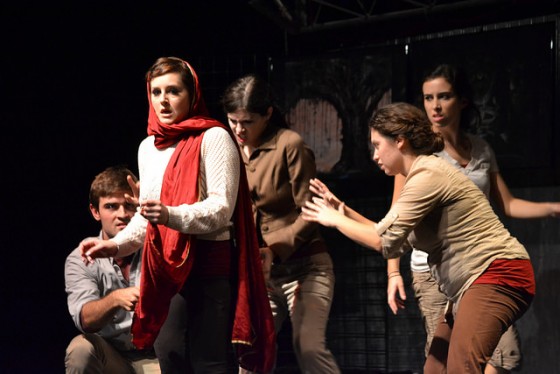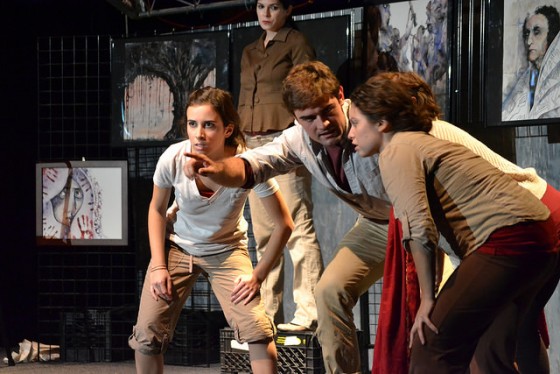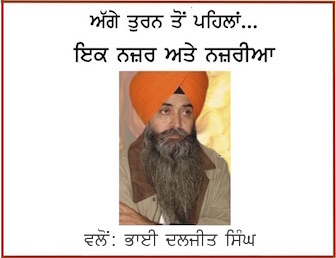Sikh Genocide 1984 » Sikh News
Kultar’s Mime – A play that recreates the anti-Sikh violence of 1984
October 9, 2014 | By Umang Kumar
Between Oct 31 and Nov 3, exactly 30 years ago in 1984, bloody violence was visited upon the Sikh community in India after the news that the then Indian Prime Minister, Indira Gandhi, had been assassinated by her Sikh bodyguards.
Sarbpreet Singh, a Sikh and a community activist in the Greater Boston area wrote a poem titled “Kultar’s Mime” in 1990. Drawing on various sources and inspirations, such as the poem ‘In The City Of Slaughter’ by Jewish poet Hayim Nahman Bialik and verses from Bhai Gurdas, a 16th century Sikh poet, Singh wrote the poem to express his own reaction to the horrific violence of 1984. He named the poem “Kultar’s Mime” after a character he read about in anthropologist Veena Das’ book on the carnage survivors in Delhi.

Kultar’s Mime – A play that recreates the anti-Sikh violence of 1984
In the book, Kultar had gone deaf and dumb after witnessing his own father’s death at the hands of rioters. Because of his disability, Kultar mimes all his actions and even re-enacts some gruesome scenes from the day his father was killed.
Asked how the poem came to be, Singh says that: “After I read a lot about what had happened in Delhi, it just poured out.”
Singh’s poem was turned into a play by his high-school-going daughter J Mehr Kaur who took it up as a challenge. She kept a lot of Singh’s verse but changed the composition of the number of players and formatted the poem to be enacted as a play.
The first performance of the play took place at the Hopkinton High School in Hopkinton, Mass. in 2013. The cast comprised local school students at that staging. “South Asian actors were never considered as the structure of the play has a group of Western artists telling the stories,” says Singh, also by way of explanation of how he subsequently decided to professionalize the production and seek actors from Stage Source, a Boston resource extensively used by the Boston theater community to post events, job opportunists and casting calls.
After a rigorous audition process, Singh found 5 actors – Addison Williams, Allison Matteodo, Cathryn Roberts, Christine Scherer and Michelle Finston – who all had a background in theater and creative arts and were ready to take up the challenge of a play like Kultar’s Mime. Singh says rehearsals with the new cast began in earnest in August 2014. Since then, the play has been staged twice in the Boston area and in New York City. It is expected to travel to various other cities.

Stills from the play – Photo – Sarbpreet Singh
Singh says the contribution of the Bridgewater, N.J. based Sikh Research Institute was crucial in putting the play together.
The play itself unfolds with an outer frame-story with the actual actors, who are part of a fictional artist collective called Applejus, reminiscing about and laboring under the memory of the Jewish pogrom in the city of Kishinev in the Russian empire in 1903, wanting to honor the victims in some way. Then one of them produces the Black Book – a chronicle of the atrocities during the 1984 massacres (the actual title of the book being, “Who are the Guilty”) – and circulates it among the others.
This prompts the decision to go to Delhi – to learn of the horrors of 1984 on their own and to embrace the pain of a different community so far removed from them in many ways:
Shall we go to Delhi then?
Seeking justice? Or revenge?
Will we rant? Will we rave?
Will we peer in every grave?
…
And yes, before we can be free,
A Kishinev new, we need to see.
And thus, with the desire to gain some reprieve and release from the burden of Kishinev’s memory, to see a “Kishinev new,” the actors and the play moves on to the inner frame story set in Delhi –
When I walk the streets of Delhi today
I still see blood mixed with the dust.
Each silent stone does seem to say
Scream out aloud you must you must.
The actors enact the various roles of rioteers and victims, including that of Kultar –
He’s a little Sikh boy; his name’s Kultar.
Lives in a place they call Jamna Paar.
See his smiling, cherubic face? He looks so cute
You can hardly tell he’s deaf and mute.
Using a variety of actions and symbolism, the play proceeds to depict various incidents of the anti-Sikh massacres – the killing of Kultar’s father as Kultar looks on, riotous mobs assaulting women and setting people on fire using gasoline –
Somewhere in the city in a darkened room
The plotters gather and make their plans
They seek to spread mayhem and doom
To begin a surreal murderous dance
Tilak Vihar is just one of the names
The rest of the city too is in flames.
Without naming names, the play manages to recreate near-real scenes with descriptions of plotters and the political leadership that urged the rioters on – and the petty “rewards” that propelled the rioters –
The trio triumphant roam the streets
Gloating at their successful plan
They marvel applaud the deadly feats
Encourage the mobs whenever they can
The murderers line up to get their fees
A bottle of liquor and a hundred rupees
This is not an easy story to tell because this is a story that continues on till today, with all the attendant horrors and memories. The “refugee camps” of survivors still exist in Delhi, filled surely with many children like Kultar. And the search for justice has proved elusive for the Sikh community with the chief accused still roaming free. As one of the characters in the play says,
You may plead for justice ‘till you die.
There’s no one to heed your desperate cry
And yet, the play does not dissolve into despair but ends on a note of hope, of a sense of the passage of time that will right the evil –
Gentle again, the wheel will turn and evil will take flight
Into a million blazing suns shattered will be the night
Into a million blazing suns shattered will be the night
With a steady rhythm and almost matter-of-fact manner of a narrative, Kultar’s Mime builds up a powerful story that manages to gripthe viewer’s imagination while not overwhelming it. In a question-and-answer session in Boston, a member of the audience said it was her hope that the play does not end up demonizing the perpetrators but attempts to see everyone as human. In response, a cast member said that the fact they play all roles – of the perpetrators and of the victims – was a way of assuming upon themselves both the responsibilities and dispositions of both the perpetrators and the victims, and also convey the same to the audience. As a verse in the play asks,
Did it happen I’m tempted to ask?
Did men become such brutal beasts?
It seems that they did turn into “brutal beasts,” as the play amply shows. And yet, despite the violence and injustice that it depicts, there is little evidence of any sense of ill-will or hatred that the play advocates. Instead, it seeks to understand and engage the tragedy by means of connections to other similar incidents, other similar sufferings.
For Singh, the play is a tribute to innocent victims of violence everywhere.”The mere act of not forgetting nameless victims is meaningful in itself,” he says, adding that, “The play intends to draw attention to this tragic cycle of meaningless violence – it is a protest against every such instance that erupts with alarming regularity all over the world, even today.”
To Get Sikh Siyasat News Alerts via WhatsApp:
(1) Save Our WhatsApp Number 0091-855-606-7689 to your phone contacts; and
(2) Send us Your Name via WhatsApp. Click Here to Send WhatsApp Message Now.
Sikh Siyasat is on Telegram Now. Subscribe to our Telegram Channel
Related Topics: 1984 Sikh Genocide, November 1984




